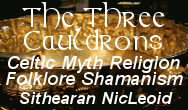Ariadne's Tribe: Minoan Spirituality for the Modern World
Walk the sacred labyrinth with Ariadne, the Minotaur, the Great Mothers, Dionysus, and the rest of the Minoan family of deities. Ariadne's Tribe is an independent spiritual tradition that brings the deities of the ancient Minoans alive in the modern world. We're a revivalist tradition, not a reconstructionist one. We rely heavily on shared gnosis and the practical realities of Paganism in the modern world. Ariadne's thread reaches across the millennia to connect us with the divine. Will you follow where it leads?
Find out all about Ariadne's Tribe at ariadnestribe.com. We're an inclusive, welcoming tradition, open to all who share our love for the Minoan deities and respect for our fellow human beings.
Two Blades: Minoan ritual labryses and practical tools
The labrys is one of the most iconic symbols of Minoan civilization. The two-bladed axe shape evokes ideas ranging from bloody human sacrifice to butterflies in a spiritual garden. I have my own ideas about what the labrys means to me, and may have meant to the Minoans as well.
One thing I've noticed, though, is that a lot of people use the term "double axe" to refer to these artifacts, conflating them with practical tools. But they're not the same thing.
If you look at the many ceremonial labryses, you'll see that they're all quite flimsy, made from thin sheet metal. Even this bronze one from Mesara is too thin be used as an actual axe (no, not even to whack the Minotaur's head off, though you might be interested to know that the Minotaur wasn't originally a monster):

"Bronze Ax Messara Crete" by Chris 73 from is licensed under CC BY 3.0 and is available at Wikimedia Commons.
The Minoans did have actual double-bladed axes that could be used for chopping wood and other practical applications. But they don't look like the ceremonial labryses. They're thick and chunky and heavy, just like modern axes. Here are a few that are in the collections at the Metropolitan Museum of Art (all images are public domain, donated to Wikimedia Commons by the museum):



It's certainly possible that the design of the practical tools is related to the design of the religious icons, though the shape of the labrys is far more flared than that of the actual axes. I find it especially interesting that even today, people in rural Crete use a double-bladed hoe that looks very much like these axes to turn the soil in their fields and gardens.
But when we're looking at the artifacts, we need to make sure to differentiate between the heavy-duty chopping tool and the lightweight religious symbol. The labrys is a "double axe" only in the loosest terms. Let's let it be its own thing, and let it inspire us in its own way.
In the name of the bee,
And of the butterfly,
And of the breeze, amen.
Main blog image: "A small golden double head minoan axe. Votive jewel. Found in Archalokori cave, 1700 - 1450 BCE." by Jebulon is licensed under CC BY 1.0 (public domain).
Comments
-
Please login first in order for you to submit comments





















Weight is an important part of a useful ax, not just for strength. A ceremonial ax would not need weight. I have never seen a butterfly with wings of that shape either. Some artistic license was taken for whatever it was originally.